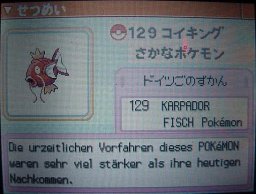Since Generation IV, which introduced Pokémon with different tags based on the language of the copy of the game they originated in (that's a mouthful), there's been a hidden, yet simple mechanic related to breeding two compatible Pokémon with different languages. If you take, for example, a German Magikarp and breed it with an English (or American, it's based on the game's language not nationality) Magikarp, the Eggs you receive have a notably higher chance of hatching into Shiny Magikarp. This particular example actually originates from the games the technique was first usable, Diamond, Pearl, and Platinum - in the post-game, an NPC would trade you a female German Magikarp in exchange for a Goldeen, which would allow you to use the Masuda method to hatch Shiny Magikarp without needing to trade with a foreign copy of the game. This mechanic is not exclusive to Gen IV, either, it can be used in any of the games following; all you need is a foreign Pokémon, which in the modern games (that still have WiFi access) is extremely easy via remote trading.
Who Says Opposites Don't Attract?

Now, you may be wondering, how much does this actually increase the odds of Shiny Pokémon? Well, it's simple: They become about six times as common as normal, across all generations. This is a dramatic increase, considering baseline odds are only around 1/4096 in newer games (VI and newer), and 1/8192 in older games (Gen IV-V). Plus, breeding is the most reliable way to obtain battle-perfect Pokémon for PvP, so if you use a foreign parent, it can add a bit of flair to your fighters.